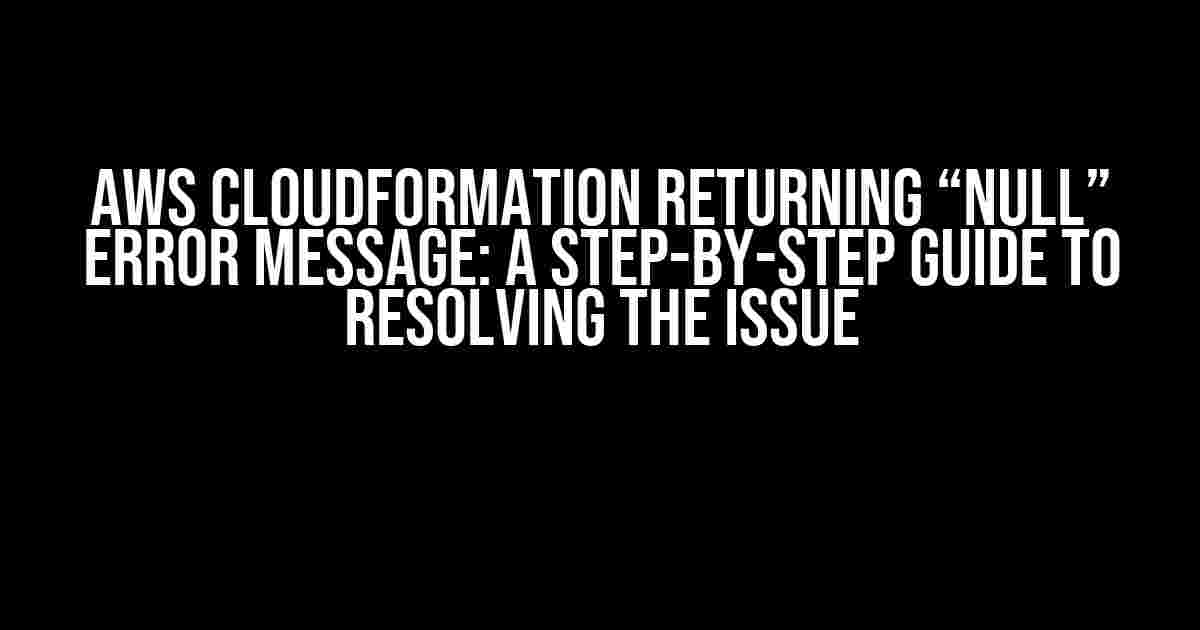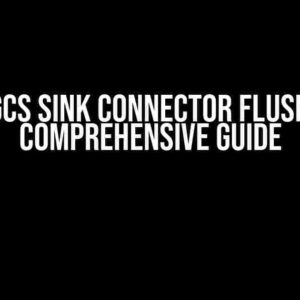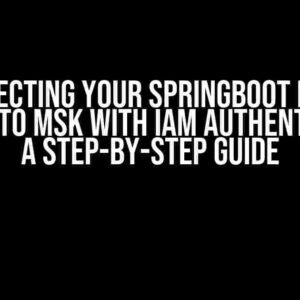Are you tired of seeing the dreaded “null” error message when working with AWS CloudFormation? You’re not alone! This frustrating issue can bring your workflow to a grinding halt, leaving you feeling stuck and confused. But fear not, dear reader, for we’re about to embark on a journey to resolve this pesky problem once and for all.
- What is AWS CloudFormation?
- The “null” Error Message: What’s Causing It?
- Step 1: Review Your Template Parameters
- Step 2: Validate Your Template Syntax
- Step 3: Check Your Permissions and Access Controls
- Step 4: Review Resource Dependencies
- Step 5: Check for Circular Dependencies
- Step 6: Check for Timeout Issues
- Common Scenarios and Solutions
- Conclusion
What is AWS CloudFormation?
Before we dive into the solution, let’s take a quick step back to understand what AWS CloudFormation is. CloudFormation is a service offered by Amazon Web Services (AWS) that allows you to use templates to define and deploy infrastructure as code. With CloudFormation, you can create and manage a collection of related AWS resources, such as EC2 instances, RDS databases, and S3 buckets, among others.
The “null” Error Message: What’s Causing It?
The “null” error message in AWS CloudFormation typically occurs when the service is unable to retrieve or process the required data. This can happen due to a variety of reasons, including:
- Incorrect or missing template parameters
- Invalid or malformed template syntax
- Insufficient permissions or access controls
- Resource dependencies or circular dependencies
- Timeout or throttling issues
Step 1: Review Your Template Parameters
The first step in resolving the “null” error message is to review your template parameters. Make sure you’re providing the required input parameters and that they’re correctly formatted.
AWSTemplateFormatVersion: '2010-09-09'
Parameters:
Environment:
Type: String
Default: dev
InstanceType:
Type: String
Default: t2.micro
Resources:
MyEC2Instance:
Type: 'AWS::EC2::Instance'
Properties:
InstanceType: !Ref InstanceType
In the example above, we’re defining two parameters: `Environment` and `InstanceType`. The `!Ref` function is used to reference the `InstanceType` parameter within the `MyEC2Instance` resource.
Step 2: Validate Your Template Syntax
A single misplaced bracket or comma can cause your template to fail. Validate your template syntax using the AWS CloudFormation validator or a third-party tool like cfn-lint.
Here’s an example of how to use the AWS CloudFormation validator:
aws cloudformation validate-template --template-body file://path/to/template.yaml
If your template syntax is invalid, the validator will provide a detailed error message indicating the issue.
Step 3: Check Your Permissions and Access Controls
Make sure you have the necessary permissions and access controls in place. CloudFormation requires the following permissions:
- cloudformation:CreateStack
- cloudformation:UpdateStack
- cloudformation:DescribeStacks
- cloudformation:ValidateTemplate
You can use the AWS IAM console or the AWS CLI to create a custom IAM role with the required permissions.
Step 4: Review Resource Dependencies
Resource dependencies can cause issues if not properly defined. Make sure you’re using the correct `DependsOn` attribute to define dependencies between resources.
Resources:
MyDBInstance:
Type: 'AWS::RDS::DBInstance'
Properties:
DBInstanceClass: db.t2.micro
Engine: mysql
MasterUsername: !Ref DBUsername
MasterUserPassword: !Ref DBPassword
MyEC2Instance:
Type: 'AWS::EC2::Instance'
Properties:
InstanceType: !Ref InstanceType
DependsOn: MyDBInstance
In the example above, the `MyEC2Instance` resource depends on the `MyDBInstance` resource. CloudFormation will create the DB instance before creating the EC2 instance.
Step 5: Check for Circular Dependencies
Circular dependencies can cause CloudFormation to return a “null” error message. Review your template to ensure there are no circular dependencies between resources.
Resources:
MyEC2Instance:
Type: 'AWS::EC2::Instance'
Properties:
InstanceType: !Ref InstanceType
DependsOn: MyRDSInstance
MyRDSInstance:
Type: 'AWS::RDS::DBInstance'
Properties:
DBInstanceClass: db.t2.micro
Engine: mysql
MasterUsername: !Ref DBUsername
MasterUserPassword: !Ref DBPassword
DependsOn: MyEC2Instance
In the example above, we have a circular dependency between the `MyEC2Instance` and `MyRDSInstance` resources. To resolve this, we need to remove the `DependsOn` attribute from one of the resources.
Step 6: Check for Timeout Issues
Timeout issues can occur if a resource takes too long to create or update. Review your template to ensure you’re using the correct `Timeout` attribute.
Resources:
MyEC2Instance:
Type: 'AWS::EC2::Instance'
Properties:
InstanceType: !Ref InstanceType
CreationPolicy:
ResourceSignal:
Timeout: PT15M
In the example above, we’re setting a timeout of 15 minutes for the `MyEC2Instance` resource. If the resource doesn’t signal creation within this time frame, CloudFormation will return a “null” error message.
Common Scenarios and Solutions
Here are some common scenarios where the “null” error message might occur, along with their solutions:
| Scenario | Solution |
|---|---|
| Using an invalid or outdated AWS::CloudFormation::Stack resource type | Update to the latest version of the resource type or use a compatible version |
| Incorrect or missing API credentials | Verify API credentials and ensure they’re correct and up-to-date |
| Resource dependencies not correctly defined | Review and update resource dependencies to ensure correct ordering |
| Timeout issues due to slow resource creation | Increase the timeout value or optimize resource creation to reduce wait times |
Conclusion
Resolving the “null” error message in AWS CloudFormation requires a methodical approach to identifying and fixing the underlying issue. By following the steps outlined in this article, you’ll be well on your way to troubleshooting and resolving this frustrating problem. Remember to review your template parameters, validate your template syntax, check your permissions and access controls, review resource dependencies, and check for circular dependencies and timeout issues.
With practice and patience, you’ll become proficient in resolving the “null” error message and master the art of AWS CloudFormation template development.
So, the next time you encounter the “null” error message, don’t panic! Take a deep breath, follow the steps outlined in this article, and you’ll be back to deploying your infrastructure as code in no time.
Frequently Asked Question
Having trouble with AWS CloudFormation returning “null” error messages? Don’t worry, we’ve got you covered! Check out these frequently asked questions to get back on track.
Why is AWS CloudFormation returning a “null” error message when I try to create a stack?
This error usually occurs when there’s an issue with the template or the input parameters. Double-check your template for any syntax errors or invalid property values. Also, make sure you’re passing the correct input parameters to the stack. If you’re still stuck, try debugging your template using the AWS CloudFormation validator tool.
Can I get a “null” error message if I’m using an outdated AWS CloudFormation template?
Yes, that’s possible! If you’re using an outdated template, it might not be compatible with the latest AWS CloudFormation version. Try updating your template to the latest version or use the AWS CloudFormation template language (JSON/YAML) to ensure compatibility.
How can I troubleshoot a “null” error message in AWS CloudFormation?
To troubleshoot a “null” error message, start by checking the AWS CloudFormation console for error messages or warnings. You can also use the AWS CloudFormation CLI command `aws cloudformation describe-stack-events` to get more detailed information about the error. Additionally, enable debugging in your template to get more insight into the issue.
Can a “null” error message occur due to permission issues in AWS CloudFormation?
Yes, permission issues can definitely cause a “null” error message in AWS CloudFormation. Make sure the IAM role or user creating the stack has the necessary permissions to access the required resources. Check your IAM policies and ensure they’re correctly configured.
Is it possible to avoid “null” error messages in AWS CloudFormation by using a linter?
-absolutely! Using a linter like cfn-lint or cloudFormation-linter can help catch syntax errors and invalid property values in your template before you even try to create a stack. This can greatly reduce the chances of getting a “null” error message.



